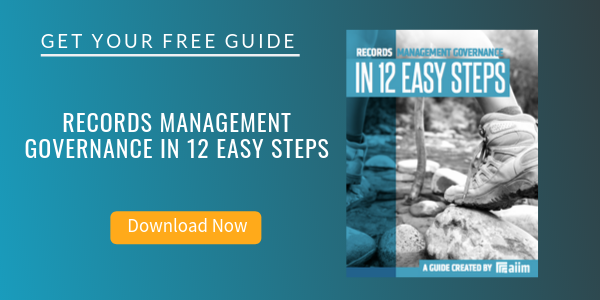
Survey: Information Governance More Prevalent, but InfoChaos Remains
AIIM recently collaborated with Cohasset Associates and ARMA in the eighth biennial survey on the evolution of Information Governance (over 1,300 participants). Over a series of blog posts, I'll cover the major highlights -- and the implications for organizations as they continue to address the tension between Information Opportunity and Information Chaos.
Overall, the survey finds that Information Governance programs are more prevalent, better designed, and inclusive of digital information (usually referred to in legal circles as Electronically Stored Information, or ESI). However, many essential implementation elements are not being addressed.
Defensible records and information management practices are founded on clear and consistent policies, retention rules, and training that result in systematic, repeatable, and measurable implementation outcomes. Modern Information Governance (IG) programs have adjusted their approach to address the realities of managing large volumes of electronically stored information (ESI).
Some key data points:
The majority of organizations (87% overall; 95% of large organizations) have a records and information management program.

Policies, standards, and procedures are being improved to address electronically stored information (63% categorize themselves as "Mature" or "Improvement Underway."
Retention schedules are becoming media-neutral (86%), are trending to fewer categories that are up-to-date (83%), and apply to all operations (88%) in all locations (85%).
Within this gradual improvement, though, there are still areas that can be improved. Cohasset recommends that organizations follow these four steps:
- Compare the maturity of foundational IG program components to modern practices and create a plan to address program gaps.
- Define an overarching IG implementation strategy that aligns implementation outcomes to business priorities.
- Commit to ongoing communication, training, and change management for all executives and employees.
- Use meaningful metrics to monitor, report, and improve implementation results.
About John Mancini
John Mancini is the President of Content Results, LLC and the Past President of AIIM. He is a well-known author, speaker, and advisor on information management, digital transformation and intelligent automation. John is a frequent keynote speaker and author of more than 30 eBooks on a variety of topics. He can be found on Twitter, LinkedIn and Facebook as jmancini77. Recent keynote topics include: The Stairway to Digital Transformation Navigating Disruptive Waters — 4 Things You Need to Know to Build Your Digital Transformation Strategy Getting Ahead of the Digital Transformation Curve Viewing Information Management Through a New Lens Digital Disruption: 6 Strategies to Avoid Being “Blockbustered” Specialties: Keynote speaker and writer on AI, RPA, intelligent Information Management, Intelligent Automation and Digital Transformation. Consensus-building with Boards to create strategic focus, action, and accountability. Extensive public speaking and public relations work Conversant and experienced in major technology issues and trends. Expert on inbound and content marketing, particularly in an association environment and on the Hubspot platform. John is a Phi Beta Kappa graduate of the College of William and Mary, and holds an M.A. in Public Policy from the Woodrow Wilson School at Princeton University.


